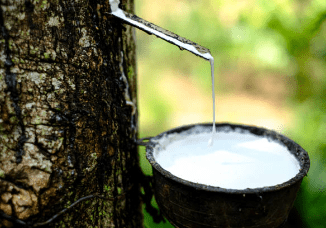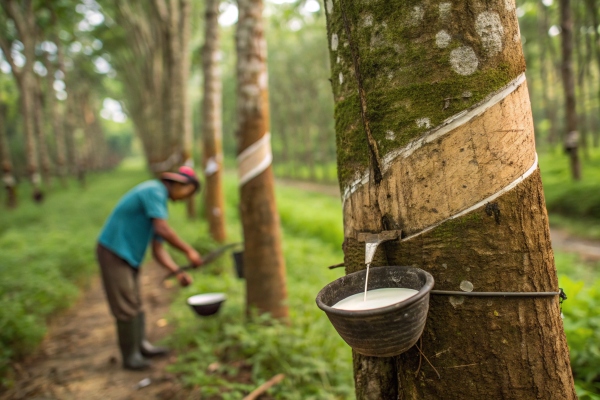Rubber is a widely used material, from tires to seals and medical equipment. But where exactly does rubber come from? This article explores both natural and synthetic rubber, their origins, and production processes.
Rubber is derived from two primary sources: natural rubber, harvested from rubber trees, and synthetic rubber, produced through chemical processes. Let’s take a deeper look at where rubber originates from and how it's made.

What Is Rubber?
Rubber is a polymer material known for its elasticity. It can stretch significantly and return to its original shape, making it ideal for various applications where flexibility and durability are required.
Rubber can be either natural or synthetic. Natural rubber is obtained from the latex sap of rubber trees, while synthetic rubber is manufactured through chemical processes that polymerize petrochemicals.
Rubber Material
Rubber is a material that exhibits elasticity, meaning it can stretch and bounce back to its original form. The key to its performance lies in its molecular structure, which allows it to absorb energy and remain flexible.
Natural rubber is made from latex harvested from rubber trees, while synthetic rubber is created by polymerizing petroleum-based compounds. Both materials are used in industries such as automotive, medical, and construction, depending on the required properties.
Types of Rubber
There are several different types of rubber, each suited to specific applications:
- Natural Rubber1 (NR): Comes from rubber trees and is known for its excellent elasticity and tensile strength.
- Synthetic Rubber2 (SR): Manufactured from petroleum-based chemicals, offering tailored properties for specific uses.
- Thermoplastic Rubber (TPR): A blend of thermoplastic and rubber materials, used in applications that require the flexibility of rubber and the processability of plastics.
- Silicone Rubber: Known for its high-temperature resistance, it is used in applications like kitchenware, medical devices, and seals.
Properties of Rubber
Rubber's most important properties include:
- Elasticity: The ability to stretch and return to its original shape.
- Durability: Rubber is resistant to wear and is ideal for heavy-duty applications.
- Flexibility: It remains flexible over a wide range of temperatures.
- Resistance to Abrasion: Rubber withstands the frictional forces in products like tires, gaskets, and hoses.
Where Does Rubber Come From?
Rubber is derived from two main sources: natural rubber, harvested from rubber trees, and synthetic rubber, which is chemically produced. Both types are used in various industries, but their production methods and applications differ.
Natural rubber comes from the latex of rubber trees, while synthetic rubber is made through chemical processes using petroleum-based products. Let’s look at where natural rubber comes from and how it’s produced.
Where Does Natural Rubber Come From?
Natural rubber is harvested from the Hevea brasiliensis tree, also known as the rubber tree, native to the Amazon rainforest. Today, rubber trees are grown in tropical regions around the world, particularly in Southeast Asia, with Thailand, Indonesia, and Malaysia being the largest producers.
Rubber trees are tapped to extract latex, a milky substance from which rubber is made. The latex is then processed into solid rubber, ready to be used in various industries.

How to Make Rubber?
The production of rubber involves two main processes: the production of natural rubber and synthetic rubber. Let’s take a closer look at how each type of rubber is made.
Natural Rubber Production3
Natural rubber production begins by tapping rubber trees4 to extract latex. The latex is then processed into solid rubber through several steps.
The latex is coagulated by adding chemicals, separating the rubber from the watery sap. The solidified rubber is then washed, dried, and pressed into sheets or bales before being ready for manufacturing.
Natural Rubber Plantation
Rubber trees are cultivated in tropical climates, requiring consistent rainfall and warm temperatures. The trees are typically grown in large plantations where they are carefully managed for optimal latex production. The tapping process involves making precise cuts in the tree's bark to extract the latex without damaging the tree.
Synthetic Rubber Production
Synthetic rubber is produced by polymerizing petroleum-based chemicals such as styrene, butadiene, and isoprene. The polymerization process involves combining these chemicals to form synthetic elastomers.
Synthetic rubber is used in applications requiring specific properties such as resistance to oil, heat, and chemicals. Types of synthetic rubber include styrene-butadiene rubber (SBR), nitrile rubber, and butyl rubber.
Synthetic Rubber vs. Natural Rubber
While both synthetic and natural rubber serve similar purposes, they have distinct advantages depending on the application.
Natural rubber is known for its superior elasticity and tensile strength, while synthetic rubber offers more resistance to heat, oil, and chemicals. Synthetic rubber is also typically more cost-effective and can be produced in large quantities.
| Property | Natural Rubber | Synthetic Rubber |
|---|---|---|
| Elasticity | High, excellent stretchability | Varies depending on the type |
| Durability | Good wear resistance | Often better resistance to heat, oils, and chemicals |
| Cost | More expensive | More affordable, mass-produced |
| Environmental Impact | Biodegradable, renewable | Made from petrochemicals, less biodegradable |
Natural rubber is ideal for applications requiring high flexibility and strength, while synthetic rubber is better suited for environments exposed to heat, chemicals, or oils.
Conclusion
Rubber comes from both natural and synthetic sources, with natural rubber being harvested from rubber trees and synthetic rubber being produced through chemical processes. Each type of rubber has its own advantages depending on the application, with natural rubber excelling in elasticity and synthetic rubber offering better resistance to heat and chemicals.
🚀 Need Custom Rubber Solutions for Your Industry?
Contact Julong Rubber today or Request a Custom Quote for high-quality, durable rubber products tailored to your needs!
-
Explore the benefits and applications of Natural Rubber to understand its significance in various industries and its unique properties. ↩
-
Learn about the various types of Synthetic Rubber and their specific applications to see how they can meet industry needs effectively. ↩
-
Discover the detailed processes involved in Rubber Production to appreciate the complexity and innovation behind this essential material. ↩
-
Discover effective cultivation techniques for rubber trees to optimize latex production and ensure sustainable practices. ↩








